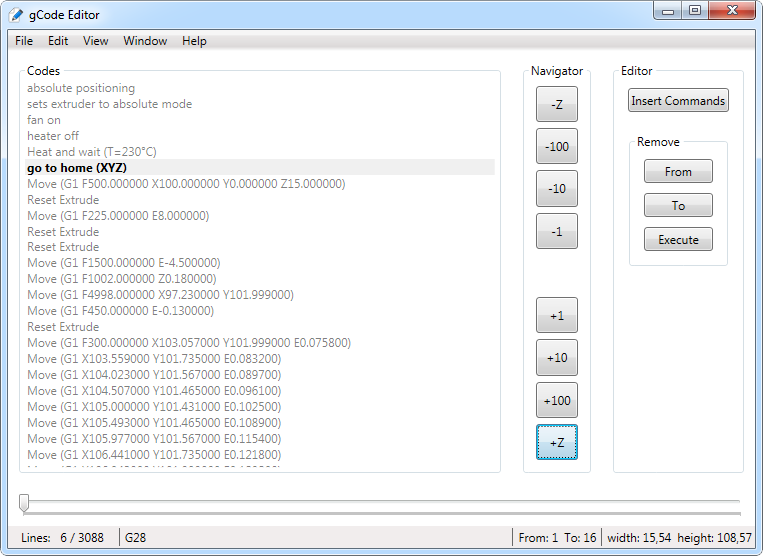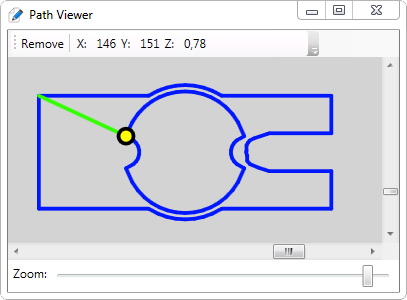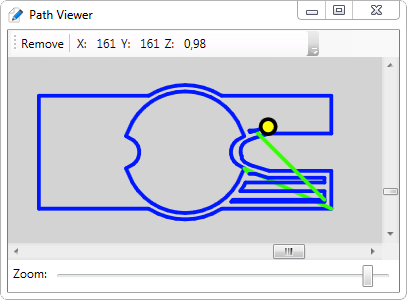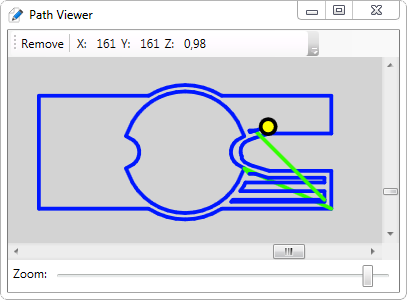The gCode Editor is a manual repair tool which helps fix issues of printing path and it can convert a general slicer-generated g-code into Petri Task File.
User Interface
As you can see the main window contains five different parts.
- The shows g-codes which are parsed to human readable form. The bold row marks the current command. You cannot select the rows, it is a viewer only. If you want to select a command you have to use the slider or the navigation buttons.
- The serves as a scroll bar to provide a navigation interface into the g-code.
- The contains the navigator buttons by which you can jump backward or forward 1, 10, 100 commands or a complete layer (Z buttons).
- The shows information about:
- The current and all line numbers of lines
- The current original g-code line without parser
- The range of selected g-code
- Size of the object. It should be smaller than the area of your dish.
- The contains Insert and remove buttons.

Convert a g-code to PTF
1. Use a general slicer program (e.g.: Cura, CraftWare, Simplify3D) to generate a g-code from your model files (e.g.: stl file).
2. Open your g-code file with the g-code editor. Click on the File menu and select Open element.
3. Remove the unnecessary initial commands.
Most slicer programs insert several initial and terminal commands which set the printing temperature or make some initial extruding or head moving. You don’t need to do these steps because the Petri Printer program will do these.
To remove the unnecessary commands, navigate to the first line of the removeable part and click the From button in the Editor area. After that navigate to the end of the removeable part and click the To button. The indexes of selected code will appear in the Status bar. Finally, click on the Execute button and the selected code will disappear.
4. Insert extra commands if needed.
The petri printer environment uses some default setting (Metric unit, Absolute Positioning, Relative mode in the extruder). If your g-code is based on different settings you should set these parameters before your code and unset them after terminating.
To insert a code, click on the Insert Commands button. After that write the necessary g-code command into the dialog box opened. Finally, click on the OK button.

5. Save the g-code in ptf format. Click on the File menu and select the Save element.
Printing Path Viewer
The Printing Path Viewer is a visualizer tool which allows to manipulate the path with the mouse. It is very useful to find and fix head movements which cross sensitive area and may cause damage to the surface.
You have three different operations to modify the g-code in the Printing Path Viewer:
I. Add extra intermediate points (fix intercross path with intermediate points).
- 1. Navigate to the beginning of g-code where you would like to insert a new point.
- 2. Hold on the Ctrl button and click with the left button of mouse on the canvas.
Unwanted crossing
Fix crossing


II. Move a point.
- 1. Navigate to the point to be moved.
- 2. Drag and drop the point with the left button of mouse on the canvas.
Path with the origianl point
Path with the point moved


II. Remove a point.
- 1. Navigate to the point to be removed.
- 2. Click on Remove button in the tool bar.
Path with the original points
Path after two points were removed

